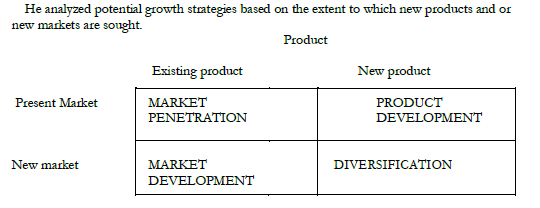
1. Market penetration
Current products and current markets. It involves achieving wider adoption of an existing product by the existing target customers.
There are 3 ways in which a company can penetrate a market.
i. Stimulating customers to increase the current rate of usage by increasing unit of customer purchase speeding up rate of product improvement/obsolescence suggesting new uses for product and offering price incentives for increased usage. For example the frequent flyers club offer by KLM and KQ to loyal customers so as to encourage them to increase bookings. After a certain mileage the customers get a free ticket.
ii. Attract non-users through promotions.
iii. Swing competitors customers through brand differentiation. It is appropriate when:
When the overall market is growing or can be induced to grow and therefore it is relatively easy to gain market share.
If the firm holds a strong market position and is able to use its experience and competences to obtain strong distinctive competences/competitive advantages.
This strategy requires relatively lower level of investment with a corresponding reduction in risk.
2. Product development
Offering new products to the present market.
By developing this strategy the company could:
Develop new product features through attempting to adapt, modify, magnify or combine existing features.
Create different quality versions of the product.
Develop additional models and sizes.
The reasons why a company may opt for this strategy are:
i. It holds a high relative market share, has a strong brand presence and enjoys distinctive competitive advantage in the market.
ii. There is growth potential in the market.
iii. The changing needs of the customers demand new products. Continuous product innovation is often the only way to prevent product obsolescence.
iv. It needs to react to technological developments.
v. The firm is particularly strong in research and development.
However this strategy has its downside especially in the line of expense and risk.
3. Market development
Process by which the firm seeks new markets for its current products. There are many possible approaches:
a) New geographical areas and export markets e.g. a radio station being a new transmitter to reach a new audience
b) New distribution channels.
c) The company may try attracting other market segments through developing product versions that appeal to them e.g. travel companies have developed a market for cheap stay long winter breaks in warmer countries for retired couples.
4. Diversification
When a company decides to make new products for new markets. The company gets involved in activities that differ from those in which it is currently involved. The company selectively changes the product lines, customer targets and manufacturing and distribution arrangements.
Diversification can either be related or unrelated.
Related: - is development beyond the present product market but still within the confines of the industry. It therefore builds on the assets or activities which the firm has developed. It takes the form of vertical or horizontal integration: - development into activities which are competitive with or directly complementary to a company’s present activity(ies).
Vertical integration: - occurs when a company becomes its own supplier or distributor. Can either be backward or forward.
Advantages
A secure supply of components or materials hence lower supplier bargaining power.
Stronger relationship with final consumer can be built.
Share of profits at all the stages of the value chain.
Creation of barriers to entry and therefore deter competitors.
Disadvantages
Over concentration in one area. Should the industry fail the whole company suffers.
Failure to reap benefits of economies of scale in the industry in which it has diversified.
Unrelated: or conglomerate is development beyond the present industry into product/markets which, at face value may bear no close relation to the present product/market.
Advantages:
a) Risk spreading:- entering new products into new markets offers protection against the failure of current products or markets
b) High profit opportunities: -stability in profits because if there are hard times in one industry they offset losses from others.
c) Better access to capital markets because of the large size “big is mighty”.
Disadvantages:
a) Lack of common identity and purpose and this could affect the focus of the firm.
b) Failure of one business drags down the rest.
Kavungya answered the question on
April 27, 2021 at 05:23